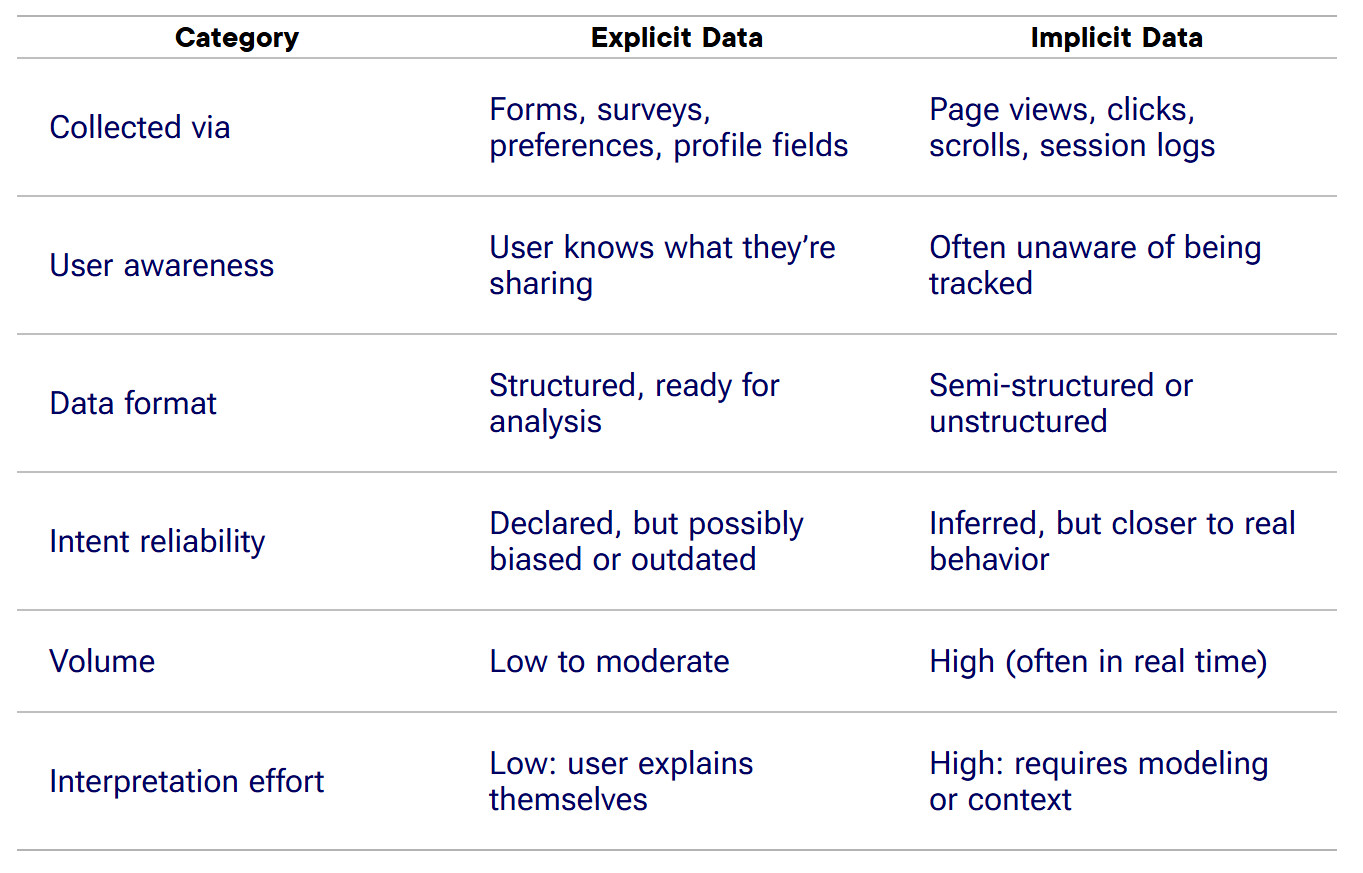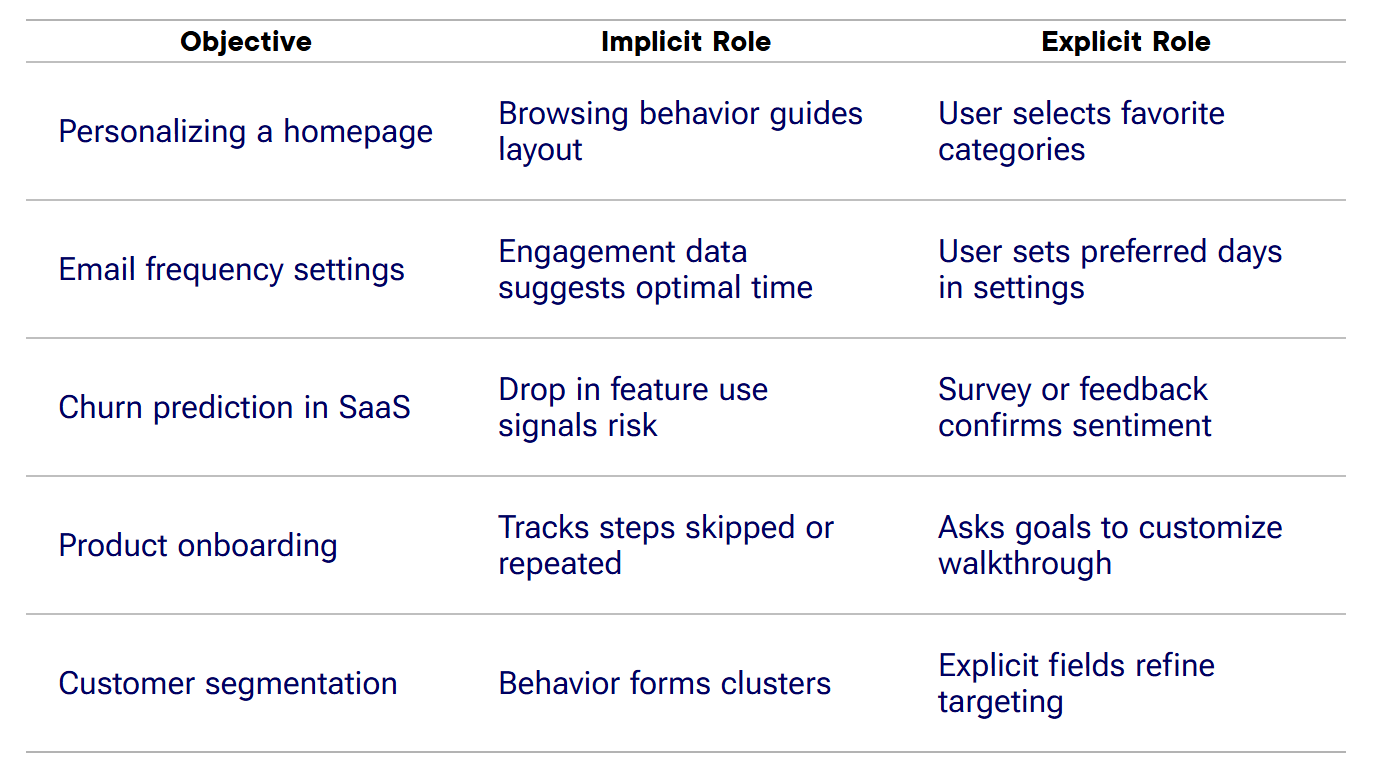.webp?2025-12-17T15:00:29.367Z)
Spotify Wrapped ideas make stats lovable

Implicit and Explicit Data in Digital Products
Understanding the difference between implicit data and explicit data is more than a semantic exercise. It’s a foundation for how modern digital products personalize experiences, segment users, and optimize conversion funnels.
Both terms refer to types of user data — but they differ in how they’re collected, what they represent, and how reliable they are.
- Explicit data is direct. It’s what users say about themselves.
- Implicit data is indirect. It’s what users do, often without realizing they’re being observed.
In 2025, the focus is shifting. As traditional data-gathering methods face increased friction from privacy laws and user skepticism, product teams and marketers are turning to behavioral signals — implicit data — to fill the gap. But the truth is: neither type is perfect on its own.
To build effective, ethical, and scalable personalization strategies, it’s essential to understand the strengths, weaknesses, and proper applications of both.
Let’s start with the basics.
What Is Explicit Data?
Explicit data is information that users intentionally and knowingly provide.
This includes:
- Form submissions (name, email, phone)
- Profile setup fields (gender, preferences)
- Survey responses
- Product reviews or feedback forms
- CRM-entered notes or user declarations (e.g., job title, company size)
In every case, the user is aware they are giving up information, usually in exchange for access, personalization, or support.
Characteristics of Explicit Data
- Voluntary: The user has control over what they share and when.
- Structured: It typically fits into clean formats like dropdowns, checkboxes, form fields.
- Contextual: It’s often specific to a product, situation, or interaction point.
Use Cases
- Building user personas
- Segmenting audiences for campaigns
- Personalizing onboarding flows
- Enriching CRM profiles for sales or support teams
Strengths
- High accuracy (if the user is motivated and honest)
- Directly maps to declared intent
- Easy to store, sort, and analyze in structured databases
Weaknesses
- Self-reporting bias: Users may misstate or simplify.
- Low volume: Many users avoid filling out forms or opt out.
- Context-dependence: The meaning of the data may degrade over time (e.g., job role changes, outdated email preferences).
For example, someone might say they’re interested in "eco-friendly products" during signup, but never click on or purchase any. This is where implicit data becomes critical.
What Is Implicit Data?
Implicit data refers to information gathered by observing user behavior, rather than by asking for it directly.
This includes actions such as:
- Pages viewed
- Time spent on a screen
- Clicks, taps, scrolls, hovers
- Search queries
- Abandonment points in a journey
- Time of day and frequency of visits
- Device usage, location patterns (when available)
The user does not explicitly declare intent. Instead, intent is inferred from behavior.
Characteristics of Implicit Data
- Passive collection: Captured without interrupting the user journey
- Unstructured or semi-structured: Often logged as events, sessions, or raw interaction logs
- Context-sensitive: Requires interpretation based on where and how it occurs
Use Cases
- Product recommendations (e.g., "people who viewed this also liked...")
- Real-time personalization of content or UI
- Churn prediction models
- Funnel optimization and behavioral segmentation
- A/B testing and usage pattern analysis
Strengths
- High volume: Implicit data is generated continuously and at scale.
- Behaviorally accurate: Actions often reveal preferences more reliably than words.
- Useful for prediction: When modeled correctly, patterns in behavior anticipate user needs or risks (e.g., drop-off before conversion).
Weaknesses
- Requires interpretation: Unlike explicit data, meaning must be extracted. This often needs AI or statistical modeling.
- Privacy concerns: Passive tracking raises ethical and regulatory questions, especially in the EU under GDPR.
- Risk of misattribution: A user might click something out of curiosity rather than intent, leading to false positives.
For example, if a user spends 30 seconds on a product page but doesn’t click "Add to Cart," implicit data might suggest interest — but not readiness to buy. This behavior, when aggregated with others, helps personalize retargeting campaigns or trigger assistive nudges like a chatbot.
Key Differences Between Implicit and Explicit Data
While both implicit and explicit data help teams understand user behavior, they differ fundamentally in source, accuracy, volume, and application. Understanding these distinctions is essential for building reliable user models and making informed decisions in product, marketing, and analytics workflows.
Source and Collection
Explicit data is collected actively, through direct user input. It requires user participation and intention.
Implicit data is collected passively, often in the background, without interrupting the user journey.

Accuracy and Context
- Explicit data is usually more precise in its original form (e.g., job title = “VP of Marketing”), but it can be outdated or inaccurate due to human error or changing contexts.
- Implicit data tends to be more reflective of real intent, but requires interpretation. A click or hover may not always mean interest; it could signal confusion or accidental interaction.
Behavioral vs. Declarative
- Explicit data = declarative: What the user says.
- Implicit data = behavioral: What the user does.
In practice, relying solely on explicit input can lead to blind spots. Users may forget to update preferences, misreport needs, or simplify responses. Implicit data fills these gaps by capturing what they actually engage with.
Why Implicit Data Is More Valuable (In Most Cases)
In 2025, digital experiences are increasingly personalized — not by what users say, but by what they do. That’s where implicit data holds the advantage. In high-velocity environments where real-time decisions matter, behavior tends to outperform self-reporting.
1. Behavior Doesn’t Lie
Users often say one thing and do another. This isn't intentional deception — it’s human nature.
For example:
- A user may select "interested in long-form content" in a preference center, but consistently bounce from articles longer than 1,000 words.
- A customer may rate a product highly in a feedback form, then never return to repurchase or engage.
Implicit data corrects for this discrepancy. It reveals what users value based on time, clicks, scrolls, and patterns — not memory or perception.
2. Passive Data Enables Real-Time Personalization
Because implicit data is captured passively and constantly, it fuels dynamic personalization. This is essential for platforms that adapt content or UI in real time:
- E-commerce sites reorder product listings based on browsing behavior.
- News apps change headlines and recommendations based on what users actually read.
- Video platforms suggest content not from declared preferences but from what’s been watched to completion.
Explicit data is often static. It can take weeks or months to update. Implicit data is alive — it updates with every interaction.
3. Implicit Data Is Scalable
You don’t need users to fill out forms or complete surveys. Every interaction generates data automatically. This is especially critical for:
- Freemium SaaS models, where most users won’t complete onboarding fully
- High-churn environments, where you need to identify disengagement early
- Mobile apps, where user friction must be minimized
Volume matters. With enough data, even noisy behavior can be modeled and corrected through pattern recognition.
4. Real-World Use: Streaming Platforms, Retail, SaaS
Here’s how implicit data powers some of the most effective digital experiences today:
- Spotify detects what time of day users stream, what they skip, and how long they listen — creating mood-based playlists and suggestions without any survey data.
- Amazon watches every scroll, dwell time, and return behavior to improve product recommendations.
- B2B SaaS companies like Intercom or Segment use feature usage logs to identify churn risk — not survey answers.
Implicit data is especially powerful in user segmentation. It allows systems to cluster users based on behavior, rather than relying on what people think describes them best.
When to Use Each Type and When to Combine Them
Neither implicit nor explicit data is universally better. Each has strengths that suit particular objectives. In practice, high-performing teams combine both to validate assumptions, enrich user profiles, and reduce blind spots.
When to Use Explicit Data
Explicit data is most effective when:
- You need consent or compliance (e.g., email opt-ins, demographic data)
- You're building onboarding flows that require user guidance
- Precision matters (e.g., selecting a subscription tier, setting preferred contact times)
- You want to personalize based on self-perception, such as style, goals, or interests
⚡ Best for declarative needs — product preference, identity, communication settings.
When to Use Implicit Data
Implicit data is ideal when:
- Users are unlikely to respond to forms or surveys
- You need to capture real behavior, not reported behavior
- You want to adapt in real time, such as content recommendations, upsell offers, or risk detection
- High volume allows for pattern recognition and predictive modeling
⚡ Best for behavioral segmentation, intent modeling, and dynamic personalization.
Combining Both: The Gold Standard
The most powerful systems use implicit data as signal and explicit data as validation — or vice versa. Here’s how:

Using both types enables more robust user modeling. It increases the reliability of automated systems and reduces reliance on either pure behavior or pure self-reporting — both of which can be misleading in isolation.
Final Thought
Understanding the difference between implicit data and explicit data is a strategic necessity. Explicit data tells you what users claim. Implicit data shows you what they actually do. Both have their place, but in today’s fast-moving, privacy-sensitive environment, the ability to learn from behavior without friction is becoming a competitive edge.
Used wisely and ethically, implicit data allows companies to personalize, predict, and adapt — all without slowing users down or relying on outdated declarations. The future belongs to systems that combine both types: clear intent + quiet observation.

